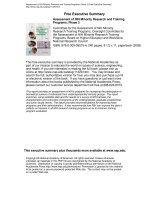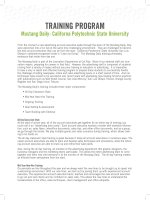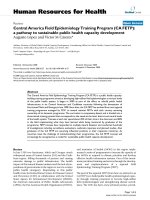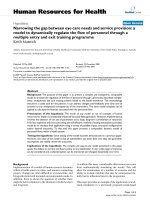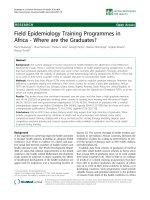glucometer training program
Bạn đang xem bản rút gọn của tài liệu. Xem và tải ngay bản đầy đủ của tài liệu tại đây (618.65 KB, 30 trang )
MEMS GLUCOMETER
TRAINING
MEMS Education Committee
2008
NOTE
Information within this presentation should be
tailored to the Blood Glucose Measuring Device
used by the service and should include a review of
the manufacturer’s instructions.
Purpose
~To prepare currently certified and future EMT-
Basics to utilize a Blood Glucose Measuring
Device under current MEMS Protocol Standards.
Objectives
At the conclusion of this program participants will
be able to:
•
State when blood glucose measuring is indicated
•
Describe the importance of a full patient
assessment in conjunction with test results
•
Demonstrate accurate calibration
•
Demonstrate appropriate procedures for measuring
blood glucose
•
Explain proper maintenance, care & storage
•
Understand the need for a CLIA Waiver
Indications for BG Measuring
Signs and Symptoms consistent with
•
Acute Stroke
•
Altered Mental Status
•
Known Diabetic Patient
•
Trauma with potential for Head/Spinal Injury
•
Combative Patient
•
Seizures
•
Overdose
•
ETC…
Altered Mental Status
(Common Causes)
AEIOU-TIPS
Alcoholism Trauma
Epilepsy Infection
Insulin Psychiatric
Overdose Stroke
Underdose
Pre-Hospital Care
(FOLLOW THE PROTOCOLS)
1. Scene Safety/Survey
2. Perform initial assessment
Considering/Treating ABC’s
3. Ensure cervical spine immobilization as indicated
4. Activate ALS-ALS must be activated when using the
glucometer.
Pre-Hospital Care
5. Perform focused history and physical exam
(a). SAMPLE history
1. Signs/Symptoms (when did they start?; how long did
they last?)
2. Allergies
3. Medications (When last taken?)
4. Prior Medical History (diabetes?, seizure disorder?)
5. Last oral intake (When did patient last eat)?
6. Events leading to illness/injury
Pre-Hospital Care
5. Focused history & physical exam, cont.
(b). Take base line vital signs
(c). Determine blood glucose level
(d). Evidence of hypothermia/hyperthermia?
(e). Can the patient swallow normally?
Pre-Hospital Care
•
Do not administer anything orally if the patient
does not have a reasonable level of consciousness
and normal gag reflex.
•
Contact medical control prior to administering
glucose to patients suspected of Acute
Stroke/Head/Spinal Injury.
Pre-Hospital Care
6. If patient is unconscious or seizing, transport on
left side.
7. If patient’s BP drops below 100 systolic; treat
for shock
8. Monitor VS every 5 minutes if unstable; every
15 minutes if stable.
9. Notify intercepting ALS service/provider
Glucose Measuring Devices
•
Used to Check Blood Sugar Levels
•
Many different types and models
Procedures
•
Careful attention to BSI & safety
•
Select Finger
•
Massage blood into distal end
•
Clean finger with appropriate aseptic technique
(if using alcohol, let dry or wipe dry with sterile gauze)
•
Use lancet or Auto-lancet device
•
Apply drop of blood onto test strip and follow
individual glucometer instructions
•
Dispose of sharps and soiled supplies in
appropriate container
Device & Accessories
Glucometer
Test Strips
Lancet
Glucose Measuring Steps
Step #1 Step
#2
Locate Glucometer
Open Up Case
Step #3
Turn Power On
Some glucometers turn on automatically.
Know the features of the glucometer your service uses.
Device Variations
Glucose Measuring Steps, cont.
Step #4
Confirm Codes
Glucose Measuring Steps, cont.
Step #5
Insert Test Strip
Glucose Measuring Steps, cont.
Step #6
Obtain Blood Sample
Apply Drop of Blood
If inadequate up to 15 secs., add additional blood
Step #7
Glucose Measuring Steps, cont.
Glucose Measuring Steps, cont.
Step #8
Document Results
Results
•
Measured in milligrams per deciliter
•
Normal blood glucose range is typically
80-120 mg/dl (fasting)
•
Treat the patient, not the numbers
Maintenance & Calibration
•
FOLLOW MANUFACTURER’S
RECOMMENDATIONS:
•
Techniques
•
Frequency
•
Batteries
•
Care & Storage
–
Device
–
test strips
•
Temperature Can Affect Machine Accuracy!!!!
Documentation
•
Reasons for procedure
•
Time of procedure
•
Results of procedure
•
Response to treatments
•
Changes in signs/symptoms
BSI & Cleansing Issues
•
Dispose of all sharps and blood contaminated
materials properly
•
Cleanse only outside of monitor with general
disinfectant (manufacturer approved)
•
Do not immerse/ inject/spray any liquid into
device




